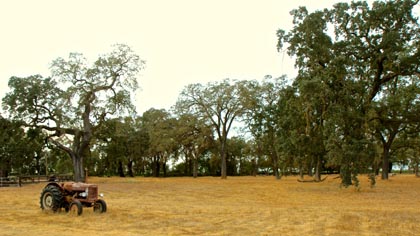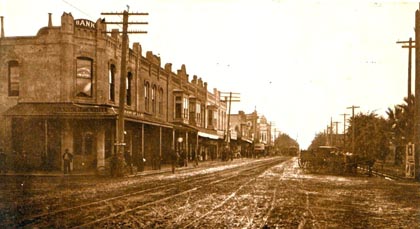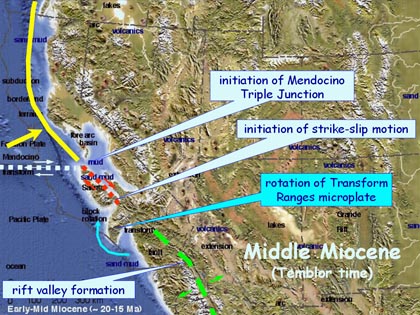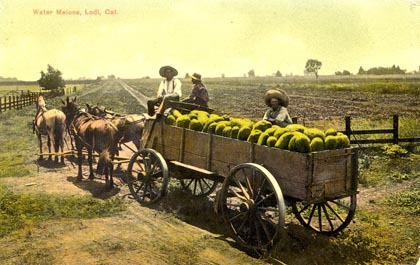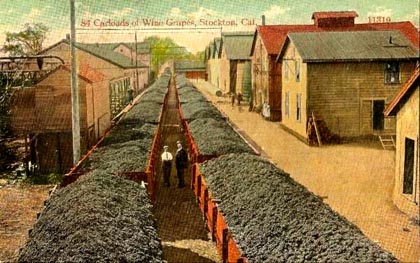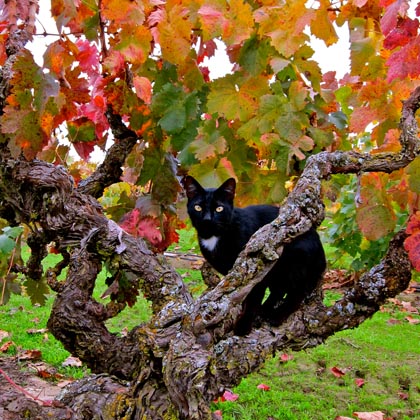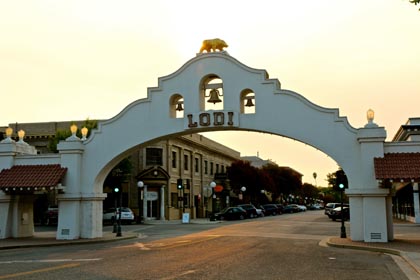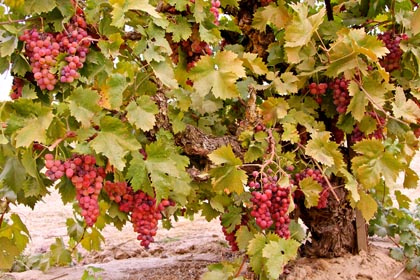Letters from Lodi
An insightful and objective look at viticulture and winemaking from the Lodi
Appellation and the growers and vintners behind these crafts. Told from the
perspective of multi-award winning wine journalist, Randy Caparoso.
A history of Lodi winegrowing, part 1
Pre-19th century Lodi: at Jessie’s Grove Winery, you can still see native grasses and ancient valley oak trees (several hundred years old) in a 32-acre grove preserved by founder Joseph Spenker and his daughter Jessie for future generations.
Mokelumne (before Lodi was Lodi)
The first settlers of European descent arrived in the area we know as Lodi in 1846; finding what Ralph A. Clark (Lodi – Images of America) described as "an abundant paradise," perched just a few feet above sea level, sandwiched between the lower foothills of the Sierra Nevada Mountains to the east, and the lower elevation wetlands of the San Joaquin-Sacramento River Delta to the west. The Delta is the only break in the coastal mountains in the entire state of California.
The Native American tribe occupying this plush pocket just prior to the onslaught of settlers from Europe or other states was the Plains Miwok; most of whom had already succumbed to a plague that ravaged all the Native American tribes in the San Joaquin Valley in 1832.
The settlement near the banks of the Mokelumne River (mokul is a corruption of the Miwok word for river, and umne means "people of") would not become known as Lodi until 1874. It was originally called Mokelumne, and officially established as a town in 1869, after a group of major landowners persuaded Central Pacific Railroad to make it a stop between Stockton and Sacramento. The site of the town's first buildings, at the corner of present-day Sacramento and Pine Streets – where the landmark Lodi Arch would later be erected (to commemorate the 1907 Tokay Carnival) – was chosen because it sits on slightly higher ground, less prone to the Mokelumne River's frequent flooding.
The first buildings next to the Central Pacific Railroad stop; at the corner of the unpaved Sacramento and Pine Streets, around the time when the town’s name was changed to Lodi in 1874
The town of Mokelumne, however, was often confused with the nearby communities of Mokelumne Hill and Mokelumne City (according to Clark, the plethora of Mokelumnes often delayed mail and hampered shipments of goods and supplies). This was what forced the eventual change in name to Lodi (according to Clark, most likely in tribute to Lodi in Italy, where Napoleon was once stopped in 1796).
Lodi was incorporated as a city in 1906; by which time agriculture was firmly established as the surrounding region's main industry: today, in 2014, led by almonds and walnuts in annual total revenue; followed close behind by wine grapes, then other fruits (particularly cherries), and an enduring dairy industry.
A land naturally conducive to agriculture
By the time the 85,700-acre American Viticultural Area (i.e. AVA) of Mokelumne River was established in 2006, the agricultural land surrounding Lodi had been known for well over a century for its deep, rich, fine, talcum powder-like soil, classified as Tokay sandy loam. This fertile, high vigor valley soil — fairly young (25,000 years) at the surface — is complimented by the same dry Mediterranean climate, and mild seasonal temperatures, typifying most of the California coast between Santa Barbara and Sonoma.
Paleogeographic map of San Joaquin Valley 20 to 15 million years ago: an inland sea where the valley is located today (courtesy of Geology of San Joaquin Valley, sjvgeology.org)
In fact, most American AVAs are not defined by nearly as much of a consistency of topography (50 to 150-ft. elevation flats, with less than 2% slopes) and single soil type as the Mokelumne River AVA. Whereas most American wine regions consist of a multiplicity of soils, slopes and elevations, in the Mokelumne River AVA there are no steep mountains or significant hills, and no rocks or even gravel: just this well drained mix of decomposed granite (derived from the base rock of the Sierra Nevada, eroded away by constant river action) and sediment washed down from the mountains, starting in the Miocene period (some 20 million years ago), when the San Joaquin Valley was still part of a huge inland sea.
Hence, when the mid-nineteenth century settlers finally arrived, they found a lush valley of grasslands and valley oaks and blue oaks, with herds of elk and antelope, grizzly bears still roaming free, and major tributaries (the Cosumnes River to the north of the Mokelumne River; and Calaveras River to the south, skirting Stockton) teeming with salmon and other fish.
According to Clark, grapes were also part of the original landscape; albeit native varieties, "growing wild dangling from the trees along the riverbanks." The nearby Calaveras River (a Spanish name, meaning "skulls," given by explorer Gabriel Moraga in 1806), in fact, was originally called 'Wine Creek' by early trappers, due to the abundance of wild vines – something you can still see today, growing among the tall trees and bushes along the banks of the river on the Sorelle Winery estate.
Just a few feet below the surface of the valley floor in the vicinity of the Mokelumne River is an enormous aquifer of water, which made the farming of a succession of major crops in this rich sandy loam that much easier. First, the early settlers successfully grew wheat and barley; and by 1880 San Joaquin Valley was actually producing the largest wheat crop in the world. When wheat prices failed, the Mokelumne River area’s high water table allowed for a flourishing watermelon industry – in fact, Northern San Joaquin Valley once held the title of "Watermelon Capital of the Country," between the late 1880s and 1900.
19th century postcard from when San Joaquin Valley was known as the “watermelon capitol of the world”
Lodi's early history of grape growing
By the time the market for watermelons began to drop during the 1890s, farmers in Lodi's Mokelumne River area were already transitioning to grapes: particularly the vivid, pink colored table grape known as Flame Tokay; although there was also a growing call for black skinned wine grapes such as Zinfandel and Carignan.
It is probably hard for anyone below the age of 30 today to imagine that Tokay, which you can no longer find in supermarkets, was once planted in every nook and cranny of Lodi. Tokay is a member of the European family of classic wine grapes, Vitis vinifera – probably originating in Algeria (where it is called Ahmer Bou'Amer) – and is a seeded, pinkish skinned grape cultivated primarily for eating, not so much for wine (although Jessie's Grove Winery still makes a rare, medium-sweet, mildly fortified varietal Tokay from its few remaining +100-year old vines).
Mokelumne River area farming families discovered Tokay's commercial potential as early as the late 1850s – most likely, even before Zinfandel became a popular planting. For most of the twentieth century Tokay was one of the most widely planted grapes in Lodi's Mokelumne River AVA, which all but disappeared by the 1980s following the development of the hybrid Flame Seedless grape, which could be grown far more easily for much lower cost further south in the Central Valley. You can still see some ancient Flame Tokay vines growing today in Lodi: sometimes a few well tended bushes in front of old homes, putting out vividly colored fruit from majestic tree-like trunks, but primarily in patches of long abandoned roadside plantings, covered with scraggly weeds.
19th century postcard of El Pinal Winery, located along railroad in Stockton
Wine grapes, of course, played a key role in Lodi's agricultural history from the beginning. Phylloxera – an insiduous root louse that temporarily maimed the California wine industry (especially in Napa Valley, Sonoma County and Livermore Valley) between the 1860s and 1880s – had absolutely no effect on Lodi's steadily growing grape industry. Why? By happenstance, phylloxera does not proliferate in sandy soils; which is why, to this day, Lodi's oldest Mokelumne River plantings (dating back to the mid-1880s) are still happily growing on their own, ungrafted rootstocks (the same phenomenon exists in nearby Contra Costa County, where soils are even sandier, and many own-rooted vines cultivated since the 1890s are still productive).
A major force in Lodi's wine history also happened to be the founder of the City of Stockton: Captain Charles M. Weber, who acquired 49,000 acres of his original holdings through a Spanish land grant. In 1850, Captain Weber planted the first vineyard in the Stockton area. Around that time, a friend of Weber's from Massachusetts named George West paid a visit, and was inspired to go into the grape growing business for himself.
In 1852, George West and his brother William West shipped in cuttings of some 40 "foreign varieties" on a steamer, sourced from a nursery in Boston. The following year they planted their first vineyard at the north end of Stockton, near the Calaveras River where it intersects with the southernmost edge of the present-day Lodi AVA; and in 1858 they established El Pinal Winery. The present-day Sorelle Winery estate sits on a small section of a vineyard property (once totaling 62 acres) that the Wests planted in partnership with Jonathan H. Dodge in 1868.
We do not have lists of all of the varieties imported by the Wests on a yearly basis during the 1850s and 1860s; but according to An Illustrated History of San Joaquin County, the inventory included Spanish and Portuguese grapes intended for the production of fortified Sherry and Port wines, as well as the seedless Sultana grape (also known as Thompson Seedless, named for a viticulturist named William Thompson who, presumably, perfected the selection of this grape, which is now responsible for 97% of the California raisin crop).
Ancient Carignan vine in Jessie’s Grove’s Royal Tee Vineyard (planted in 1889)
During the next four decades the Wests focused on grape growing for raisins, the table market, and for wine. El Pinal Winery also became known for its brandy, as well as a Claret style wine (the latter made from unnamed "Bordeaux" grapes). In his book, Zinfandel: A History of a Grape and Its Wines, Charles Lewis Sullivan writes that the Wests were cultivating Zinfandel at least by the 1860s; and that in 1883 an El Pinal Zinfandel was submitted to a viticultural convention in San Francisco.
Sullivan also cites a surprising innovation: noting that El Pinal's technique of turning free-run Zinfandel juice into a pinkish wine was so highly thought of that California viticultural commissioner Charles Wetmore – another pioneer of California white wines, and also the founder of Livermore Valley's Cresta Blanca Winery (in 1882) – openly advocated the use of Zinfandel to produce a "white" wine. If this story is true, this wine probably qualifies as the world's first "White Zinfandel" – something that other California vintners would not begin to experiment with again until the late 1960s and early 1970s (although in the 1860s, the Buena Vista Vinicultural Society is thought to have utilized Zinfandel to produce sparkling wines, which would have also required use of free-run juice).
There are also documents listing a variety of grapes supplied by El Pinal's nursery – another one of the Wests' businesses – preserved by the family of Joseph Spenker, who purchased cuttings in 1885 to plant on his 1,000-acre property just west of the town of Lodi (the Jessie's Grove estate now dominates most of Spenker's original square-mile property).
In 1886 Spenker planted 25 acres of a "Black Malvoisie" (later identified as Cinsaut), which is still cultivated by Spenker's heirs: a block known today as Bechthold Vineyard, and revered as the oldest continuously farmed vineyard in Lodi today. At the same time, Spenker planted grapes from cuttings listed by El Pinal's nursery as Madeline, Black Hamburg, Sweetwater, Black Ferra, and Emperor – although, unlike the Bechthold Vineyard Cinsaut, these curiously named varieties would eventually be pulled out.
Lodi’s Sacramento and Pine Streets today…
In 1889, Spenker planted a second vineyard consisting primarily of Zinfandel, interplanted with Carignan, Mission, Tokay, and Black Prince (the latter, also often called Rose of Peru). This block – today called Royal Tee Vineyard – is Lodi's oldest Zinfandel-dominated planting, and is still cultivated by Spenker's heirs, Wanda Woock Bechthold and her son Greg Burns (who operates Jessie's Grove Winery).
It is thought that, by the 1890s, the two most widely planted grapes in the Mokelumne River area were Tokay and Zinfandel, and there were several wineries established as well. According to Clark: "In 1901, the local newspaper declared that wine production was 'the coming industry for this part of the state.'"
The West family continued to dominate local wine production through the early 1900s; dictating prices to many of Lodi's growers. By the turn of the century, according to Clark, "angry" vineyard owners were prompted to form several co-operatives: a business model – where growers own the winery and divide profits among themselves – that would thrive in the Lodi region up until the 1970s.
To be continued: A history of Lodi winegrowing, part 2 (1900 to today)
Massive, prolific ancient Flame Tokay vine on Schmiedt Rd. (after raising canes for over 100 years, almost all the remaining vines were pulled out earlier this year)
